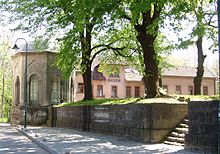Bihać
Template:Bosnia and Herzegovina municipalities


Bihać (Cyrillic: Бихаћ) is a town and municipality on the Una River in the north-western part of Bosnia and Herzegovina, center of the Una-Sana Canton of the Federation of Bosnia and Herzegovina.
History
The town was first mentioned as early as 1260 as property of a church in Topusko, Croatia in a document by the Hungarian-Croatian king Bela IV, and became a free city in 1262. Bihać was the temporary capital of the Croatian Kingdom. It lost its civic status in the 14th century following dynastic struggles in the kingdom, and became a property of the Frankopan nobles. In the 16th century it passed under direct royal rule, when battles with the Ottoman Empire had begun. The town of Bihać, in the region of the same name, withstood the Ottoman attacks until it fell with the Bosnia sanjak (in 1592).
The Bihać fort would become the westernmost fort taken by the Ottoman army over a hundred years later, in 1592 under the Bosnian vizier Hasan-pasha Predojević, previous orthodox bosnians - Valacchi (Vlah in bosnian). The city was initially made the center of the Bihać sanjak, part of the Bosnian pashaluk. It was demoted in 1699 to become part of the sanjak of Bosnia, during the period of intense border wars between the Habsburg monarchy and the Ottoman Empire. In 1865 it became the center of its own sanjak, but this lasted only until 1878, when all of Bosnia was occupied by Austria-Hungary.
A period of peace followed, marked by the 1888 bringing down of the fortress walls that separated the inner city from the outskirts. The new government had several schools and civic facilities built, which boosted the city's growth. It remained prosperous after the establishment of Yugoslavia, the center of the western Bosnian region, though its growth was impaired by the Great Depression in the 1930s.
During World War II it served as headquarters for the liberation army of Josip Broz Tito, the seat of the first AVNOJ session in 1942 and the center of the anti-fascist resistance. As such, it became a target of the occupying powers and the Germans retook it in 1943 and held it until 1945 and their final defeat.
Bihać suffered the destruction of many buildings during the recent Bosnian War, when the area around the city was under siege by the Bosnian Serb forces for over three years, until the summer of 1995 when the siege was broken in the beginning of the croats Operation Storm.
Demographics
Ethnically speaking, in the census of 2006, the whole Bihać municipality had 105,000 residents, including:
- 85% Muslims by nationality (Bosniaks)
- 4% Serbs
- 9% Croats
- 2% others
According to the 1991. census the municipality had a population of 70,732, including:
- 46,737 - 66.07% Muslims by nationality
- 12,689 - 17.93% Serbs
- 5,580 - 7.88% Croats
- 4,356 - 6.15% Yugoslavs
- 1,370 - 1.93% others and unknown
According to the 1981. census the municipality had a population of 65,544, including:
- 40,041 - 61.09% Muslims by nationality
- 11,093 - 16.92% Serbs
- 5,855 - 8.93% Croats
- 7,364 - 11.23% Yugoslavs
- 1,191 - 1.81% others and unknown
According to the 1971. census the municipality had a population of 58,185, including:
- 37,325 - 64.14% Muslims by nationality
- 12,096 - 20.78% Serbs
- 6,824 - 11.72% Croats
- 1,133 - 1.94% Yugoslavs
- 807 - 1.38% others and unknown
Settlements (over 1,500 residents), 1991. census
total: 45,553
- 27,418 - 60.18% Muslims by nationality
- 8,218 - 18.04% Serbs
- 4,805 - 10.54% Croats
- 4,020 - 8.82% Yugoslavs
- 1,092 - 2.42% others and unknown
total: 2,574
- 2,498 - 97.04% Muslims by nationality
- 49 - 1.90% Serbs
- 1 - 0.03% Croats
- 11 - 0.42% Yugoslavs
- 15 - 0,58% others and unknown
total: 2,118
- 1,975 - 93.24% Muslims by nationality
- 71 - 3.35% Serbs
- 2 - 0.09% Yugoslavs
- 70 - 3.30% others and unknown
total: 1,833
- 1,779 - 97.05% Muslims by nationality
- 1 - 0.05% Croats
- 1 - 0.05% Serbs
- 4 - 0.21% Yugoslavs
- 48 - 2.61% others and unknown
total: 1,724
- 1,297 - 75.23% Muslims by nationality
- 339 - 19.66% Serbs
- 12 - 0.69% Croats
- 70 - 4.06% Yugoslavs
- 6 - 0.34% others and unknown
Features


The city and the region are now becoming a viable tourist destination for its natural beauty. The Una river valley where Bihać is situated provides the best route from Zagreb to Dalmatia so the traffic position is also favorable. There's also a yearly regatta held on the Una, as well as the Bihać Summer theatrical event.
Education
The University of Bihać was opened in 1997 and it has seven faculties: technical, economics, law school, biotechnical, pedagogical, medical college, Islamic pedagogical academy.
Sport
The local football club is NK Jedinstvo.
Economy
Bihać is home to a beer brewery which makes the award winning Preminger.
External linksWikimedia Commons has media related to Bihać. Gallery
|







